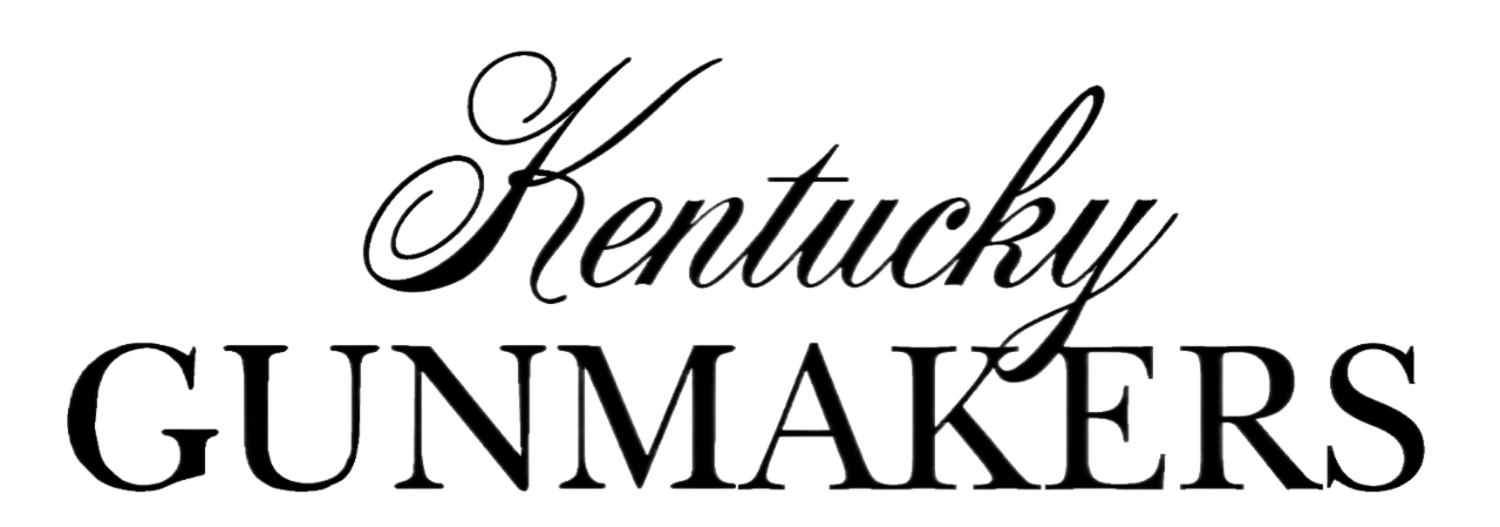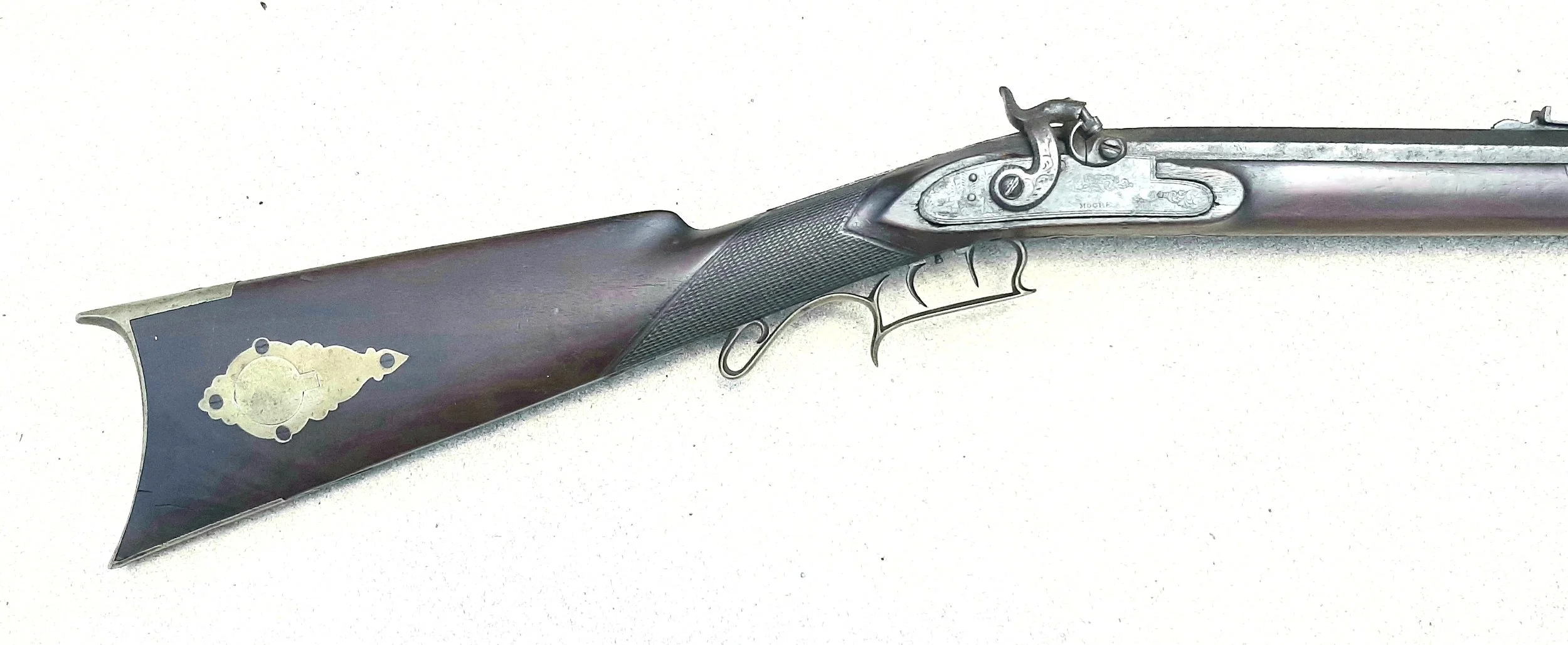Rare Florida Rifle by Gunsmith Calvin Oak of Jacksonville ©
Foreword: Among eastern states, Florida has proven to be one of the most difficult states for researching early gunsmiths and locating examples of their work. Despite its early Spanish history beginning in the sixteenth century and later French and English settlements, Florida’s economic development was slow with growth primarily in its northern agricultural regions and along coastal waterways. After Florida joined the United States in 1821, towns and businesses grew, but gunsmithing was only a small part of the expanding economy with few documented gunmakers and even fewer surviving examples of their work. When a rare Florida rifle appears at auction, it is a major event for collectors.
Unexpected Appearance: The author had been living in Florida for several winter seasons before he began looking for Florida rifles. He became intrigued with them from comments by antique dealers, pawn shops, and local gun shops that early Florida guns were nonexistent. Even collectors and dealers at local Florida gun shows had almost no knowledge of Florida guns or where one could be found. Florida had a different topography than northern states that lessened the need for firearms. The reduced demand for guns made Florida less attractive to eastern gunsmiths when they decided to relocate, so most moved to more promising states that were often easier to get to. Many early Florida towns did not have a gunsmith, and early state records show only a handful working in a few [but not all] of the state’s larger towns… and those gunsmiths often had other jobs in order to make a living. Early civilian gun production in Florida was limited, making surviving examples rare today. In 2019 a half-stocked rifle from the mid-1850s appeared at auction in California with the barrel signature, “C. Oak & Son, Jacksonville, Fla.” Calvin Oak of Jacksonville, Florida, was one of Florida’s few documented early gunsmiths and an interesting character in northern Florida’s history. The author saw the auction listing and was able to acquire the rifle reasonably… probably because most Floridians had given up looking for their rifles.
Figure No.1: The Calvin Oak rifle is well-made with a checkered wrist, good stock architecture, and German silver hardware. The stock and bore show little wear, probably due to the reduced use of rifles in Florida where hunting and target shooting were not major pastimes as they were in northern states. The adjustable rear sight and later style guard suggest a mid-century date, and Oak’s occupational changes date the rifle to between 1851 and 1856. Barrel: 35 inches long, 7-groove rifling, .50 caliber bore. Author’s collection at time of photography.
The Gunsmith: Calvin Oak was born in Vermont in 1806. He learned the gunsmith’s trade while growing up and worked at the trade for twenty-four years at Grafton in Windham County, Vermont. In 1851 Oak was diagnosed with tuberculosis and told he had six months to live, but a warmer climate might prolong his life. Later that year Oak moved to Jacksonville, Florida, then a fledgling port town on the St. Johns River on/near Florida's northeastern Atlantic coast. The town’s primary business was exporting Florida lumber consisting of pine and southern oak to northern states for shipbuilding. The warmer climate suited Oak, his health improved, and he lived another thirty years before dying in 1881. Oak was the town’s first permanent gunsmith when he opened his shop on Bay Street in 1851. He worked hard to better himself in Jacksonville, eventually becoming a leading businessman, city alderman, tax assessor, and one of the town’s wealthiest citizens. But his later financial success did not come from gunsmithing. Oak worked as a gunsmith from 1851 until 1856, then opened the first mortuary in Jacksonville and later added the related business of importing marble. The signed “C. Oak & Son” rifle was made between 1851 and 1856, before he switched to the mortuary business and selling marble grave markers and coffins. His advertisements after 1856 no longer mentioned gunsmithing, suggesting it was a less profitable business in Jacksonville that he had moved away from.
Figure No.2: The front of the Calvin Oak rifle shows its walnut stock, German silver mountings, and fancy cap box with acorn finial. The gun is well-made, nicely checkered on the wrist, and has survived in very good condition.
Figure No.3: The back of the Oak rifle is decorated with a large eagle inlay in the later style oval cheekpiece, and a fancy lock bolt washer with scrolled ends. Oak was an accomplished gunmaker, despite facing limited demand in Jacksonville.
Figure No.4: The barrel on the Oak rifle is clearly stamped with three separate stamps as “C. Oak & Son/Jacksonville/Fla.” leaving no doubt about where the gun was made, and by whom.
When Oak advertised his gunsmith’s business in Jacksonville, he boasted that he was, “prepared to manufacture at short notice any kind of rifle or other gun in a style unsurpassed by other manufactures.” [The Florida News, Jacksonville, December 31, 1853, p.1, col.4] His auction rifle supports his claim; it exhibits fine styling, workmanship. and wood-to-metal fit. The rifle is well-stocked in good quality walnut with German silver mountings. It has a finely checkered wrist, cap-box in the butt, eagle inlay in the cheekpiece, and a fancy trigger guard. The somewhat surprising large .50 caliber bore was probably intended for local game that included wild hogs and alligators. But the gun also could have been made for someone heading west, perhaps to seek gold in California, where larger animals such as buffalo, bear, and deer would be encountered along the way… which might explain how the gun ended up in California. Oak’s oldest son, Edward, worked with his father in the gun shop, and Oak stamped his rifles, "C. Oak & Son, Jacksonville Fla." on top of the barrel. When Oak went into the mortuary business in 1856, he did so with his third son, Byron, leaving oldest son Edward to run the gun shop.
Figure No.5: This image of Calvin Oak shows him in his later years when a wealthy mortician and leading citizen in Jacksonville. His move, which started out as a way to salvage his health, ended up being a highly successful financial and social venture for a man who began his career as a gunsmith.
Figure No.6: This clipped advertisement for Oak’s gunsmithing services in Jacksonville is dated “Nov. 17” but the year is missing. However, with his occupational changes, the advertisement had to appear between his arrival in1851 in Jacksonville, and 1856 when he went into the mortuary business.
Summary: The Calvin Oak rifle is a rare piece of Florida history, documenting Florida’s early gunmaking trade despite its limited following. The gun is one of only a few known Florida rifles, another of which is also a Calvin Oak product. How the rifle ended up in an old northern California gun collection remains a mystery. It may have gone west in the California gold rush era or perhaps was made for the western trade as Easterners migrated west in the mid-to-late 1800s to homestead new lands. Or it may have accompanied a much later Florida family moving to California in the 20th century. Regardless, it is a rare example of an early, clearly marked Florida firearm hand-built by one of the State’s few documented early gunsmiths.
Author’s Note: During his last winter season in Florida in 2020-2021, the author sold the Calvin Oak rifle to a Florida collector who had searched for years but was never able to find a Florida marked rifle. It was a satisfying sale, leaving the rifle “at home” in Florida in a collection where it would be appreciated, treasured, and undoubtedly shared with others.






